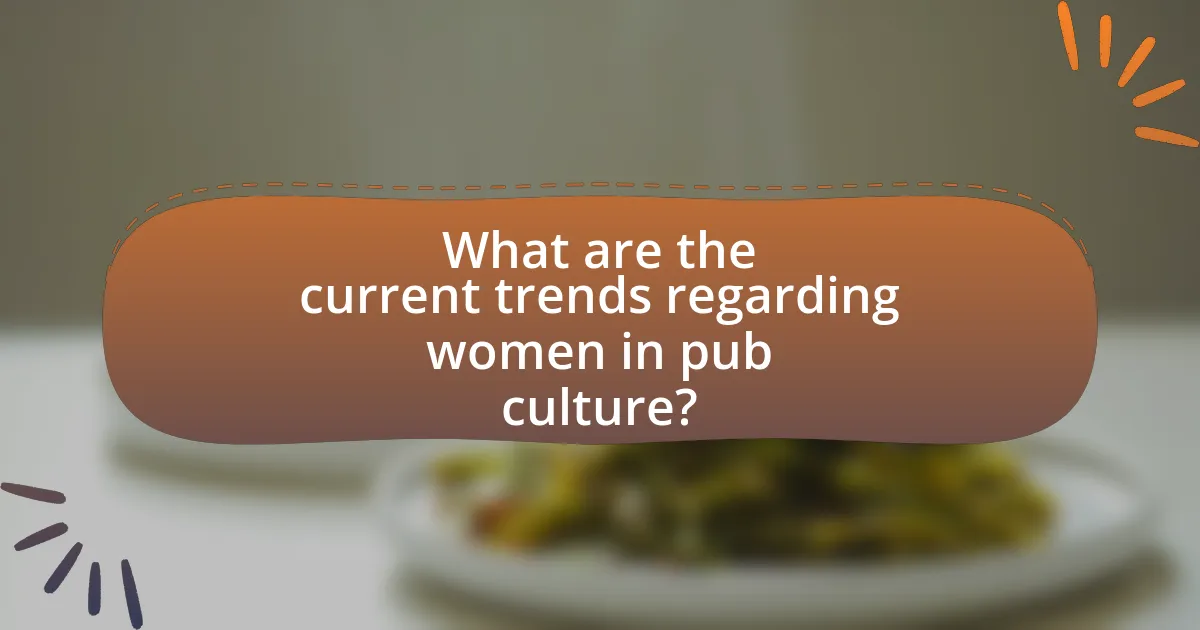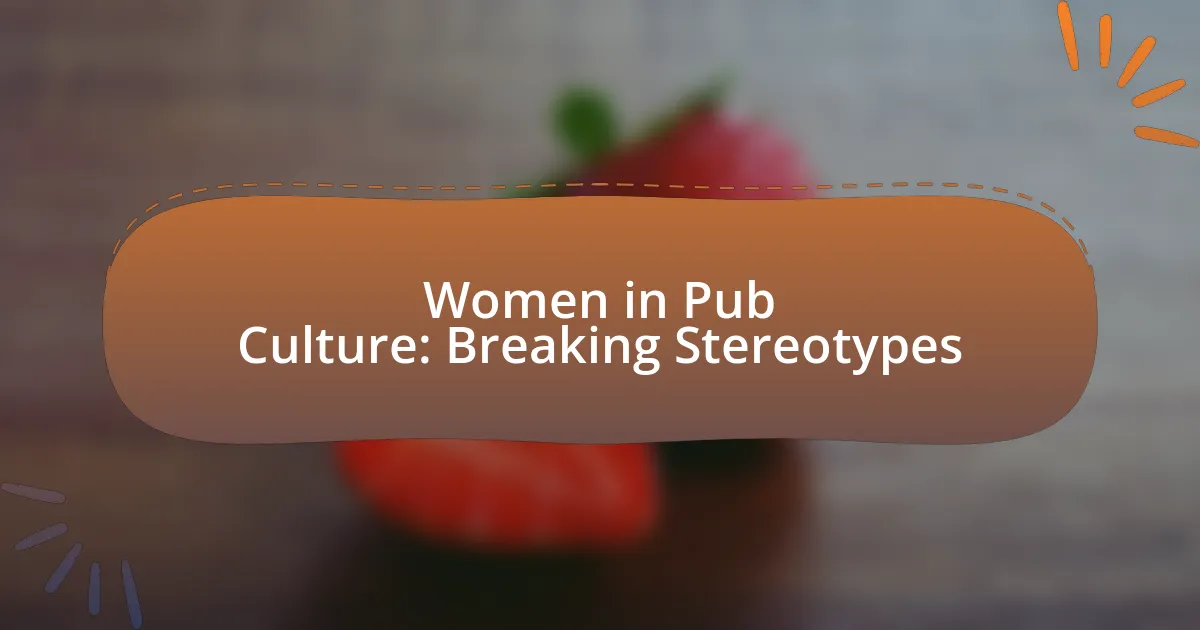The article focuses on the evolving role of women in pub culture, highlighting their significant contributions in challenging traditional gender stereotypes and enhancing social dynamics within these spaces. It examines the historical perceptions of women in pubs, the stereotypes that have shaped their experiences, and the progress made towards inclusivity and equality. Key discussions include the impact of female patrons on social interactions, the influence of women in pub design and atmosphere, and the ongoing challenges they face, such as safety concerns and underrepresentation in leadership roles. The article emphasizes the importance of breaking stereotypes to foster a more welcoming environment for women and outlines practical steps for pub owners to create inclusive spaces.

What is the role of women in pub culture?
Women play a significant role in pub culture by challenging traditional gender stereotypes and contributing to the social dynamics of these spaces. Historically, pubs have been male-dominated environments, but recent trends show an increasing presence of women as patrons, staff, and owners, which fosters inclusivity and diversity. Research indicates that women’s participation in pub culture enhances social interactions and community building, as they often bring different perspectives and approaches to socializing. For instance, a study by the University of Leeds found that women are more likely to engage in conversations that promote social cohesion, thereby enriching the pub experience for all patrons.
How have women historically been perceived in pub culture?
Women have historically been perceived in pub culture as marginalized figures, often viewed through a lens of stereotypes that emphasize their roles as either objects of male attention or as unwelcome intruders in a male-dominated space. This perception is rooted in societal norms that have traditionally associated pubs with masculinity and male bonding, leading to the exclusion or objectification of women. For instance, in the 19th century, women were often prohibited from entering pubs or were relegated to specific areas, reinforcing the notion that these establishments were primarily for men. Additionally, studies have shown that women who frequented pubs faced scrutiny and were often labeled as “unladylike,” further entrenching the stigma surrounding their presence in such environments.
What stereotypes have shaped women’s experiences in pubs?
Stereotypes that have shaped women’s experiences in pubs include the perception that women are less knowledgeable about alcohol and that they are primarily present for socializing rather than drinking. These stereotypes often lead to women being treated as outsiders in a traditionally male-dominated environment. Research indicates that women frequently face judgment or harassment when they assert their presence in pubs, which can discourage them from fully engaging in the pub culture. For instance, a study by the University of Kent found that women reported feeling unwelcome in many pub settings due to these ingrained stereotypes, which can create a hostile atmosphere and limit their social interactions.
How have these perceptions evolved over time?
Perceptions of women in pub culture have evolved significantly from the late 20th century to the present day. Historically, women were often viewed as inappropriate participants in pub settings, associated primarily with domestic roles and excluded from the drinking culture dominated by men. However, the feminist movements of the 1970s and 1980s began to challenge these stereotypes, advocating for women’s rights and their presence in social spaces, including pubs.
By the 1990s and early 2000s, the rise of women-centric pubs and bars reflected a shift in societal attitudes, showcasing women as active consumers and contributors to pub culture. Research indicates that as gender equality discussions gained traction, women increasingly embraced their right to socialize in traditionally male-dominated environments, leading to a more inclusive atmosphere.
Today, women are not only frequent patrons of pubs but also hold managerial and ownership positions, further transforming the landscape. This evolution is evidenced by statistics showing a growing percentage of women participating in pub culture, with surveys indicating that nearly 50% of pub-goers are now women, highlighting a significant shift in perceptions and acceptance.
What contributions have women made to pub culture?
Women have significantly contributed to pub culture by challenging traditional gender roles and fostering inclusivity. Historically, women have played vital roles as patrons, owners, and staff in pubs, which has helped to reshape the social dynamics within these spaces. For instance, the rise of women-led pubs and breweries, such as BrewDog’s “Feminist Beer” initiative, highlights their influence in promoting gender equality in the industry. Additionally, women have been instrumental in creating safe and welcoming environments, leading to the establishment of initiatives like “Ladies’ Nights” and women-focused events that encourage female patronage. These contributions not only enhance the cultural fabric of pubs but also promote a more diverse and equitable drinking culture.
In what ways have women influenced pub design and atmosphere?
Women have influenced pub design and atmosphere by advocating for more inclusive and welcoming environments. Their involvement has led to the incorporation of features such as comfortable seating, better lighting, and diverse beverage options, which cater to a broader audience. For instance, the rise of female-led pubs has often emphasized a more relaxed atmosphere, contrasting with traditional male-dominated spaces. Research indicates that pubs owned or managed by women tend to prioritize community engagement and social events, fostering a sense of belonging. This shift not only enhances the overall experience for patrons but also challenges long-standing stereotypes associated with pub culture.
How have female patrons changed the social dynamics in pubs?
Female patrons have significantly transformed the social dynamics in pubs by fostering inclusivity and altering traditional gender roles. Historically, pubs were predominantly male spaces, but the increasing presence of women has led to a more balanced social environment where diverse interactions occur. Research indicates that establishments that welcome female patrons often experience a shift in atmosphere, promoting a more relaxed and communal vibe. For instance, a study by the Institute of Alcohol Studies found that pubs with a higher percentage of female customers report increased patronage and improved customer satisfaction, demonstrating that women’s presence positively influences the overall pub culture.

Why is it important to break stereotypes in pub culture?
Breaking stereotypes in pub culture is important because it fosters inclusivity and equality, allowing diverse groups, particularly women, to feel welcomed and represented. Stereotypes often perpetuate exclusionary practices and limit participation, which can lead to a homogenous environment that does not reflect the community’s diversity. Research indicates that when women are included in pub culture, it not only enhances social dynamics but also contributes to economic growth; for instance, a study by the British Beer and Pub Association found that increasing female patronage can significantly boost sales and customer satisfaction. Therefore, dismantling stereotypes is essential for creating a more equitable and thriving pub culture.
What impact do stereotypes have on women’s participation in pubs?
Stereotypes significantly hinder women’s participation in pubs by perpetuating the notion that these spaces are predominantly male-oriented environments. This perception discourages women from entering pubs due to fears of judgment or harassment, as evidenced by a study from the University of Kent, which found that 60% of women reported feeling uncomfortable in male-dominated social settings. Additionally, stereotypes that portray women as less interested in drinking culture further marginalize their presence, leading to a lack of representation and reinforcing the cycle of exclusion.
How do stereotypes limit women’s social interactions in these spaces?
Stereotypes limit women’s social interactions in pub culture by perpetuating the belief that women do not belong in these spaces or should behave in a certain way. This results in women facing social barriers, such as being judged for their presence or being subjected to unwanted attention, which can discourage them from engaging fully. Research indicates that women often experience a hostile environment in pubs, where traditional gender roles dictate that they should be passive or reserved, leading to reduced opportunities for networking and forming connections. For instance, a study published in the Journal of Gender Studies highlights that women frequently report feeling marginalized in male-dominated social settings, which reinforces their exclusion and limits their social interactions.
What are the consequences of these stereotypes for pub owners and staff?
Stereotypes about women in pub culture can lead to significant consequences for pub owners and staff, including reduced customer diversity and potential loss of revenue. When pub owners and staff adhere to traditional gender roles, they may alienate female patrons and discourage women from pursuing careers in the industry, resulting in a less inclusive environment. Research indicates that establishments with diverse staff attract a broader customer base, enhancing profitability. For instance, a study by the McKinsey Global Institute found that gender-diverse companies are 21% more likely to outperform their counterparts in profitability. Thus, stereotypes not only harm the workplace culture but also negatively impact the financial success of pubs.
How can breaking stereotypes benefit pub culture as a whole?
Breaking stereotypes can significantly enhance pub culture by fostering inclusivity and diversity, which attracts a broader customer base. When traditional gender roles are challenged, women feel more empowered to participate in pub culture, leading to increased patronage and varied social interactions. Research indicates that establishments with diverse clientele often experience higher revenue and customer satisfaction, as they create environments where different perspectives and experiences are valued. For instance, a study by the British Beer and Pub Association found that pubs that actively promote gender diversity see a 20% increase in overall sales compared to those that do not. This shift not only benefits the financial aspect of pubs but also enriches the social fabric of the community, making pubs more welcoming and vibrant spaces for all.
What positive changes can occur when women are embraced in pub culture?
When women are embraced in pub culture, positive changes include increased social inclusivity and enhanced community engagement. The presence of women in pubs can lead to a more diverse atmosphere, which fosters a sense of belonging for all patrons. Research indicates that establishments with a balanced gender representation often experience higher customer satisfaction and increased patronage, as women tend to create a more welcoming environment. Furthermore, the integration of women in pub culture challenges traditional gender stereotypes, promoting equality and encouraging a shift in societal norms regarding gender roles in social settings. This shift can result in a broader acceptance of diverse social interactions, ultimately enriching the cultural fabric of the community.
How does inclusivity enhance the overall pub experience for all patrons?
Inclusivity enhances the overall pub experience for all patrons by creating an environment where diverse groups feel welcome and valued. This welcoming atmosphere encourages a broader range of customers, leading to increased social interaction and a richer communal experience. Research indicates that inclusive spaces can boost customer satisfaction and loyalty; for instance, a study by the American Psychological Association found that diverse environments foster creativity and innovation, which can translate into unique pub offerings and events that appeal to a wider audience. Furthermore, inclusivity can reduce barriers for marginalized groups, such as women, thereby promoting gender equality and breaking stereotypes within pub culture. This not only enhances the experience for those individuals but also enriches the social fabric of the pub, making it a more vibrant and engaging place for everyone.

What are the current trends regarding women in pub culture?
Current trends regarding women in pub culture indicate a significant increase in female patronage and participation in traditionally male-dominated spaces. Research shows that women now represent approximately 40% of pub-goers, reflecting a shift towards inclusivity and diversity in social drinking environments. Additionally, many pubs are actively creating female-friendly atmospheres by offering events tailored to women, such as cocktail nights and book clubs, which further encourages female engagement. This trend is supported by the rise of female-led breweries and pub ownership, which challenges historical stereotypes and promotes a more balanced representation in the industry.
How are modern pubs adapting to attract female patrons?
Modern pubs are adapting to attract female patrons by creating inclusive environments that prioritize comfort, safety, and diverse offerings. Many establishments are redesigning their spaces to include cozy seating areas, improved lighting, and decor that appeals to a broader audience, moving away from traditional masculine aesthetics. Additionally, pubs are expanding their drink menus to feature a variety of cocktails, wines, and non-alcoholic options, catering to different tastes and preferences.
Furthermore, some pubs are hosting events specifically aimed at women, such as cocktail-making classes, book clubs, and wellness nights, which foster community and engagement. Research indicates that women are more likely to frequent venues that offer a welcoming atmosphere and a sense of belonging, reinforcing the importance of these adaptations in attracting female patrons.
What role do events and promotions play in engaging women in pubs?
Events and promotions play a crucial role in engaging women in pubs by creating inclusive and appealing environments that cater to their interests. These activities often feature themes, entertainment, and social opportunities that resonate with women, such as wine tastings, ladies’ nights, and live music events. Research indicates that targeted promotions can increase female patronage; for instance, a study by the British Beer and Pub Association found that pubs offering women-focused events saw a 30% increase in female customers. By fostering a welcoming atmosphere and addressing the preferences of women, pubs can effectively enhance their engagement and participation in the pub culture.
How are social media and marketing strategies influencing women’s presence in pubs?
Social media and marketing strategies are significantly increasing women’s presence in pubs by creating targeted campaigns that resonate with female audiences. For instance, platforms like Instagram and Facebook allow pubs to showcase inclusive environments and events specifically designed for women, such as cocktail nights or women-only gatherings. Research indicates that 54% of women feel more inclined to visit establishments that actively promote gender-inclusive events, as highlighted in a study by the University of Leeds. Additionally, influencer partnerships on social media amplify these messages, making pubs more appealing to women by fostering a sense of community and belonging.
What challenges do women still face in pub culture today?
Women still face significant challenges in pub culture today, including gender-based harassment, unequal treatment, and a lack of representation in decision-making roles. Gender-based harassment remains prevalent, with studies indicating that approximately 70% of women report experiencing unwanted attention or harassment in nightlife settings. This creates an unwelcoming environment that discourages women from fully participating in pub culture. Additionally, women often encounter unequal treatment, such as being served last or receiving less attention from staff compared to male patrons. Furthermore, the underrepresentation of women in leadership positions within the pub industry limits their influence on policies and practices that could foster a more inclusive atmosphere. These challenges highlight the ongoing need for cultural change within pub environments to ensure safety and equality for women.
How do safety concerns affect women’s choices in pub environments?
Safety concerns significantly influence women’s choices in pub environments by leading them to select venues perceived as safer and more welcoming. Women often prioritize establishments with good lighting, visible security, and a reputation for respectful behavior among patrons. Research indicates that 70% of women report feeling unsafe in nightlife settings, which directly impacts their decision to visit certain pubs or to go out at all. This heightened awareness of safety risks can result in women opting for venues that are more familiar or recommended by friends, thereby limiting their social experiences and reinforcing existing stereotypes about women’s roles in nightlife.
What barriers remain for women seeking leadership roles in the pub industry?
Barriers that remain for women seeking leadership roles in the pub industry include gender bias, lack of mentorship, and work-life balance challenges. Gender bias manifests in hiring practices and workplace culture, often leading to women being overlooked for promotions or leadership positions. A study by the British Beer and Pub Association found that only 27% of senior roles in the pub sector are held by women, highlighting the systemic nature of this bias. Additionally, the absence of mentorship programs specifically for women limits their professional development and networking opportunities, further hindering their advancement. Lastly, the demanding hours and late-night shifts typical in the pub industry create significant work-life balance challenges, disproportionately affecting women who often bear greater family responsibilities.
What practical steps can be taken to foster a more inclusive pub culture?
To foster a more inclusive pub culture, establishments should implement gender-neutral policies, such as ensuring equal representation in staff hiring and promotions. Research indicates that diverse teams enhance creativity and decision-making, which can lead to a more welcoming environment for all patrons. Additionally, pubs can host events that celebrate diversity, such as women-led music nights or themed discussions on gender issues, which can attract a broader audience and encourage participation from underrepresented groups. Providing training for staff on inclusivity and sensitivity can further enhance the atmosphere, as studies show that well-trained employees create a more welcoming environment, reducing instances of discrimination or harassment.
How can pub owners create a welcoming environment for women?
Pub owners can create a welcoming environment for women by implementing inclusive policies and fostering a safe atmosphere. This can be achieved through staff training on gender sensitivity, ensuring adequate lighting, and maintaining a zero-tolerance policy for harassment. Research indicates that establishments with well-trained staff and clear policies report higher satisfaction among female patrons, as seen in a study by the Institute of Alcohol Studies, which found that 70% of women feel more comfortable in venues that prioritize safety and inclusivity.
What initiatives can be implemented to support women in the pub industry?
To support women in the pub industry, initiatives such as mentorship programs, training workshops, and flexible work arrangements can be implemented. Mentorship programs can connect experienced female pub professionals with newcomers, fostering guidance and career development. Training workshops focused on skills such as bartending, management, and customer service can empower women with the necessary expertise to excel in the industry. Additionally, flexible work arrangements can accommodate women’s diverse responsibilities, making it easier for them to balance work and personal life. These initiatives are supported by studies indicating that mentorship and training significantly enhance career advancement opportunities for women in male-dominated fields.
